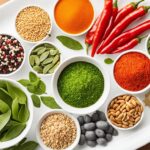Are you tired of constantly battling food cravings and struggling to stay satisfied throughout the day? Well, get ready to outsmart your stomach with the revolutionary “Always Full” Diet! This diet is designed to help you feel satisfied and curb those pesky cravings by tricking your stomach into thinking it’s full.
Imagine never having to worry about that nagging hunger again or falling into the trap of mindless snacking. With a few clever diet tricks and fullness hacks, you can learn how to stay fuller for longer and avoid overeating. Say goodbye to the never-ending cycle of dieting and hello to a newfound sense of satisfaction.
Let’s dive into the world of satiety strategies and uncover the secrets to achieving the impossible: feeling always full. Get ready to say goodbye to dieting misery and hello to a lifetime of delicious meals and guilt-free indulgence. Are you ready to embark on this mouthwatering adventure? Let’s go!
Key Takeaways:
- The “Always Full” Diet helps you stay satisfied throughout the day and curb food cravings.
- By implementing certain diet tricks and fullness hacks, you can trick your stomach into feeling full.
- Satiety strategies focus on nutrient-dense foods and portion control to keep you feeling satisfied.
- The “Always Full” Diet encourages mindful eating, increased fiber intake, and balanced macronutrients.
- Stay hydrated and incorporate hydrating foods to enhance satiety and suppress appetite.
The Science Behind Satiety and Hunger
The science behind satiety and hunger is fascinating and multifaceted. Understanding the intricate mechanisms of our body’s hunger cues and appetite control can provide valuable insights into how we can trick our stomachs into feeling satisfied. By delving into the science, we can uncover effective strategies for optimizing satiety and avoiding constant hunger pangs.
One key aspect of satiety is the role of certain foods in promoting feelings of fullness and reducing appetite. Protein-rich foods, such as lean meats, poultry, fish, and plant-based protein sources like beans and tofu, are particularly effective in enhancing satiety. Including these nourishing foods in your meals can help curb cravings and keep you feeling satisfied for longer periods.
Fiber also plays a crucial role in satiety. Fibrous foods like whole grains, fruits, vegetables, and legumes add bulk to your meals, creating a sense of fullness and reducing the urge to overeat. Incorporating these fiber-rich options into your diet not only promotes satiety but also supports healthy digestion.
Another important consideration for satiety is the balance of macronutrients – protein, fats, and carbohydrates – in our meals. Each macronutrient plays a unique role in promoting fullness and providing sustained energy. By including adequate amounts of all three macronutrients in your diet, you can optimize satiety and maintain a healthy balance.
“Understanding the intricate mechanisms of our body’s hunger cues and appetite control can provide valuable insights into how we can trick our stomachs into feeling satisfied.”
To paint a clearer picture of the science behind satiety and hunger, here is a table summarizing the different factors that influence our sense of fullness:
| Factors | Effects |
|---|---|
| Protein-rich foods | Promote feelings of fullness and reduce appetite |
| Fiber-rich foods | Add bulk to meals, enhance fullness, and support healthy digestion |
| Balanced macronutrients | Promote sustained fullness and provide essential nutrients |
By understanding the science behind satiety and hunger, you can make informed choices that support lasting feelings of fullness. Incorporating nourishing foods, such as protein-rich and fibrous options, and maintaining a balanced macronutrient intake can help you optimize satiety and achieve your health goals.
Key Points:
- The science behind satiety and hunger revolves around hunger cues and appetite control.
- Protein-rich and fibrous foods promote feelings of fullness and decrease appetite.
- Balancing macronutrients is essential for sustained fullness and energy.
Now that we understand the science behind satiety and hunger, let’s explore how mindful eating and portion control can further enhance satiety on the “Always Full” Diet.
Mindful Eating and Portion Control
When it comes to successfully implementing the “Always Full” Diet, mindful eating and portion control are two powerful tools in your arsenal. By being more intentional about how you eat and paying attention to your body’s hunger signals, you can better control your portion sizes and avoid the trap of overeating.
So, what exactly is mindful eating? It’s the practice of being fully present and aware of what you’re eating, savoring each bite, and truly enjoying the flavors and textures. This approach encourages you to slow down and listen to your body’s cues, allowing you to recognize true hunger and fullness.
Mindful eating can revolutionize your relationship with food. By taking the time to really savor and appreciate each bite, you’ll find that you feel more satisfied and fulfilled after a meal, even if you’ve eaten smaller portions.
One effective technique to practice mindful eating is to slow down your eating pace. Chew each bite thoroughly, allowing your brain to register the food’s taste and texture. Not only does this enhance your overall eating experience, but it also gives your body enough time to signal feelings of fullness.
Another trick to aid portion control is to use smaller plates and bowls. This visual trick can trick your brain into perceiving larger portions, resulting in greater satisfaction with smaller amounts of food. It’s a simple yet effective way to feel more satiated without overloading your plate.
Remember, it takes about 20 minutes for your brain to register fullness. So, slow down, savor every bite, and give your body the chance to send those important signals of satisfaction.
Here’s a helpful table summarizing the key benefits of mindful eating and portion control:
| Benefits of Mindful Eating and Portion Control |
|---|
| Enhances satiety and satisfaction |
| Helps you recognize true hunger and fullness cues |
| Prevents overeating and promotes portion control |
| Encourages a more mindful and enjoyable eating experience |
By incorporating mindful eating and portion control into your “Always Full” Diet journey, you’ll not only feel more satisfied with your meals but also gain a deeper appreciation for the food you eat. Remember, it’s not just about what you eat, but also how you eat it.
Strategies for Increasing Fiber Intake
Looking to trick your stomach into feeling satisfied? Increasing your fiber intake is a smart strategy. High-fiber foods are your best friends when it comes to adding bulk to your meals and promoting feelings of fullness. Include these fiber-rich recipes in your diet to support gut health and keep hunger at bay. Remember, aim to consume the recommended daily intake of fiber for ultimate satisfaction.
Fiber-Rich Foods to Incorporate
- Fruits: Apples, berries, oranges
- Vegetables: Broccoli, carrots, spinach
- Whole grains: Oats, quinoa, brown rice
- Legumes: Chickpeas, lentils, black beans
Add these fiber heroes to your grocery list and get creative in the kitchen with fiber-rich recipes. Experiment with wholesome ingredients that will make your taste buds dance and your stomach happy.
“A high-fiber diet keeps you regular and provides a sense of fullness. Remember, keeping your gut healthy is a key ingredient to overall well-being.”
Try this Fiber-Rich Recipe:
| Fiber-Rich Salad | Ingredients | Instructions |
|---|---|---|
| https://www.youtube.com/watch?v=wD8reCw3Kls |
|
|
Eat your way to a healthier gut and increased satisfaction with fiber-rich foods. Your journey to feeling always full just got tastier!
Hydration and Its Impact on Satiety
When it comes to feeling satisfied and avoiding unnecessary snacking, hydration is your secret weapon. Drinking enough water throughout the day can help you feel fuller and curb your appetite. So, before you reach for that tempting bag of chips, reach for a glass of water instead.
The “Always Full” Diet understands the power of hydration in promoting satiety. By prioritizing drinking water for fullness, you can trick your stomach into believing it’s more satisfied than it actually is. Hydrating foods, such as cucumbers, watermelon, and soups, can also contribute to your overall hydration levels and enhance the feeling of fullness.
Staying properly hydrated can amplify the effects of other satiety strategies and prevent dehydration-related hunger cues. By quenching your thirst and maintaining optimal hydration levels, you can improve your ability to listen to your body’s true hunger signals and avoid mistaking thirst for hunger.
So, remember, in your quest for always feeling full, don’t underestimate the power of hydration. Drink water for fullness, incorporate hydrating foods into your meals, and stay properly hydrated throughout the day. Your stomach will thank you, and your cravings will be kept at bay.
Balancing Macronutrients for Sustained Fullness
Balancing macronutrients is like conducting a gourmet orchestra in your stomach. Each macronutrient plays a vital role in promoting sustained fullness and keeping those hunger pangs at bay. Let’s dive into the symphony of flavors and nourishment that will leave you feeling satisfied throughout the day.
First up, we have protein – the virtuoso of fullness. Including an adequate amount of protein in your meals can be even more satisfying than finally catching up on your favorite TV show. Protein not only reduces cravings but also promotes the release of hormones that signal satiety to your brain. Incorporating lean meats, poultry, fish, tofu, and legumes into your meals will ensure you’re getting the protein you need to keep you feeling full and satisfied.
Next, say hello to the maestro of satiety – healthy fats. Contrary to popular belief, not all fats are created equal. Healthy fats, such as avocados, nuts, seeds, and olive oil, provide a slow-burning energy source that keeps you feeling fuller for longer. These fats also amplify the flavors of your meals, making every bite a mouthwatering symphony of taste and satisfaction.
But what about complex carbohydrates? Don’t worry, they’re like the supporting cast that plays a crucial role in maintaining that fullness harmony. Complex carbohydrates, found in whole grains, fruits, and vegetables, provide a steady stream of energy that keeps you feeling satisfied without the dreaded energy crashes. They also add a delightful array of textures and colors to your meals, creating a visual feast that makes your taste buds sing.
“Balancing macronutrients is key to feeling satisfied and energized throughout the day. It’s like finding the perfect balance in a beautiful melody – each macronutrient adds its own unique element to create a symphony of fullness.” – Nutrition Maestro
To help you visualize this orchestra of fullness, feast your eyes on this table that showcases the essential macronutrients and food sources:
| Macronutrient | Primary Food Sources |
|---|---|
| Protein | Lean meats, poultry, fish, tofu, legumes |
| Healthy Fats | Avocados, nuts, seeds, olive oil |
| Complex Carbohydrates | Whole grains, fruits, vegetables |
Now that you’re armed with the knowledge of balancing macronutrients, it’s time to create your own culinary masterpieces. Experiment with different combinations and proportions to find what works best for you. Remember, the secret to sustained fullness lies in the perfect symphony of protein, healthy fats, and complex carbohydrates. So go ahead, enjoy the delicious harmony of flavors while keeping your stomach blissfully satisfied.
Conclusion
So there you have it! The “Always Full” Diet is your secret weapon to achieving satiety and long-term success in maintaining a healthy weight. With a combination of mindful eating, portion control, increasing fiber intake, staying hydrated, and balancing macronutrients, you can trick your stomach into feeling satisfied and curb those pesky cravings.
It’s important to remember that finding the right strategies that work for you may require a bit of trial and error. So don’t be discouraged if the first approach doesn’t yield immediate results. Stay committed and patient, because achieving satiety is a journey, and each person’s path may look a little different.
Take the time to experiment with different techniques and discover what makes you feel always full. Maybe you find that eating slower and savoring each bite enhances your satisfaction, or perhaps increasing your fiber intake does the trick. Whatever it may be, trust yourself and your body to guide you towards optimal fullness.
So go forth and master the art of feeling always full! Your body and mind will thank you for it as you achieve your weight goals and bid farewell to constant food cravings.
FAQ
How does the “Always Full” Diet work?
What are some strategies for increasing satiety?
How can I practice mindful eating and portion control?
How can I increase my fiber intake?
How does hydration impact satiety?
Why is balancing macronutrients important for satiety?
How can I achieve long-term success with satiety?
MORE SOURCES TO READ:
- https://blog.thenewyouplan.com/faqs/
- https://tim.blog/2008/01/18/how-to-cut-weight/comment-page-2/
- https://cynthiathurlow.com/ep-331-hunger-habit-impact-of-lifestyle-self-talk-and-trauma-with-dr-jud-brewer/
![]()














Recent Comments